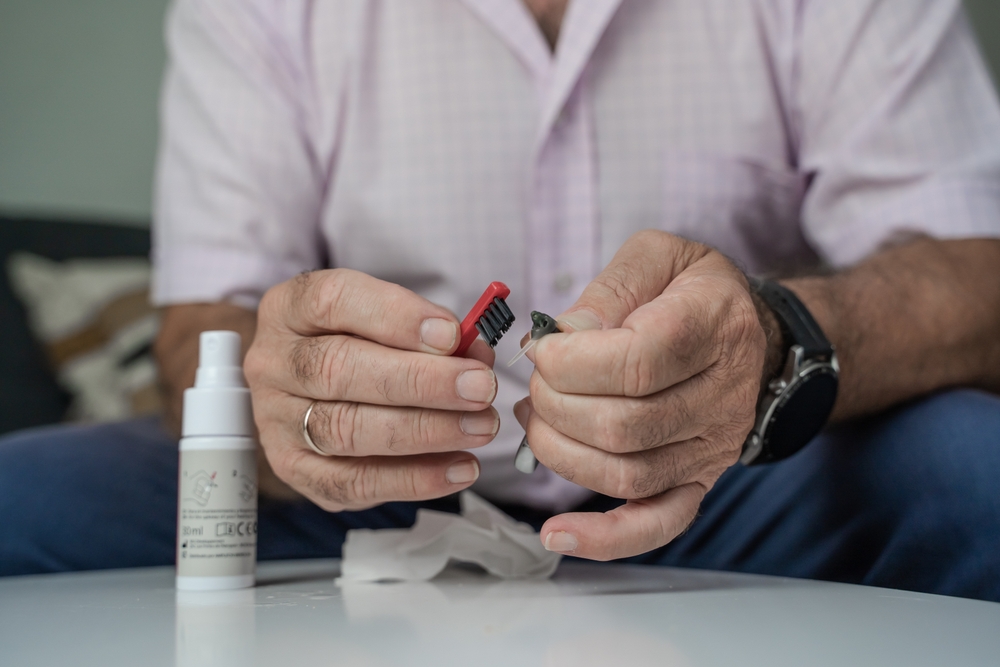
For individuals who have hearing loss, hearing aids are crucial for better hearing and general quality of life. They do, however, need to be regularly cleaned and properly maintained just like any technology does. Regular maintenance can considerably increase their lifespan and ensure you’re hearing clearly. In this guide, we’ll walk through the steps to properly clean and care for your hearing aids.
Keeping your hearing aids clean and getting professional tunings
You should clean your hearing aids once a week or more. The longevity of your hearing aid will be extended, and the sound quality will be improved by performing a quick, easy cleaning routine.
Together with your regular at-home care, periodic professional maintenance by a hearing specialist is recommended. It’s comparable to a dental visit where professional cleanings are essential alongside your regular at-home cleaning and maintenance routine. A deep clean by a professional is advised every six months or so. This helps to identify any issues your device might have and helps keep it in prime working condition.
Basic daily care tips
Taking a few basic precautions can greatly enhance the longevity and performance of your hearing aids. Avoid common obstacles by utilizing these tips:
- Protect From Extreme Temperatures: Avoid exposing your hearing aids to severe weather conditions. If it’s particularly cold or hot, leave your devices inside instead of bringing them outside.
- Safe Storage: When they’re not being used, keep your hearing aids stored in a protective case or in their charger to avoid exposure to dirt or physical damage.
- Before Handling, Clean Your Hands: Skin oils and debris can interfere with the function of your hearing aids so make sure you wash and dry your hands before handling them.
- Clean Before Bed: When you clean your hearing aids at night they will be totally dry by the time you wake up and put them back in.
- Use a Dehumidifier: If it’s really humid, a dehumidifier can be utilized to keep the moisture away from your hearing aids.
- Keep Them Dry and Chemical-Free: Moisture and chemicals can be damaging to your hearing aids. Be certain to remove them before taking a shower, swimming, or applying products like hairspray or perfume.
Tools for proper hearing aid care
You will require the appropriate tools to properly maintain your hearing aids. Here are some of the things you can expect to find in a hearing aid care kit:
- Cleaning brush: For cleaning excessive wax and dust.
- Microfiber cloth: Perfect for wiping down the surface of your hearing aids.
- Hearing aid dryer: Dries any moisture built up after using the device all day.
- Wax pick or loop: For gently cleaning out earwax from small crevices.
- Slim tube cleaner: For removing debris trapped in the tubes.
Our hearing specialists can help you keep your hearing aids in tip-top working order by guiding you to the appropriate tools and maintenance techniques.
Detailed cleaning determined by hearing aid type
There are some minor differences in how you clean different models of hearing aids. Here are customized cleaning instructions for two common types of hearing aids: In-The-Ear (ITE) and Behind-The-Ear (BTE).
How to clean In-The-Ear (ITE) hearing aids
- Clear the Ventilation Tube: Push a slim cleaning tool through the vent tube to ensure there’s no obstruction.
- Brush Debris Away: Gently wipe away any earwax or debris from the surface of your hearing aid while holding it face down.
- Wipe the Exterior: Use a soft microfiber cloth to clean the whole outer surface, removing any residue.
- Remove Wax with a Loop: Use a wax loop or pick to thoroughly extract any remaining earwax.
Cleaning Behind-The-Ear (BTE) hearing aids
- Use a Wax Pick: Use a loop pick to remove any stubborn wax that may remain.
- Detach the Tubing: Begin by detaching the tubing from the hearing aid itself.
- Soak the Ear Mold: Remove and soak the ear mold in warm, soapy water to release any accumulation. Utilize a tubing blower to get rid of excess moisture and dry with a clean cloth.
- Clean the Microphone Openings: Free the microphone of debris by brushing its opening.
- Reassemble and Test: Reassemble and test your hearing aids after everything is dry.
- Clean the Aid: Gently wipe off any dirt or wax while holding the device face down, paying particular attention to the portion around the receiver and microphone.
- Clear the Tubing: Clean the exterior of the tube with a cloth after pushing a pipe cleaner through it.
Preventing ear infections with proper hygiene
Cleaning your ears is just as important as cleaning your hearing aid. Excessive accumulation of earwax can negatively affect the functionality of your hearing aid and cause your ears discomfort and potentially infection. These problems can usually be avoided by regularly cleaning your ears and hearing aids.
Make an appointment to have your hearing aids cleaned by a professional
Contact us right away if you would like to schedule a consultation to go over any concerns you might have about hearing aids.
Professional maintenance is key to ensuring your hearing aids continue to serve you well for years to come.